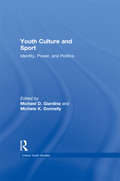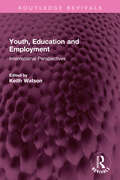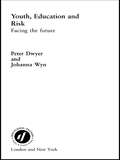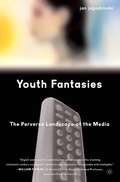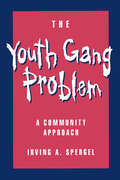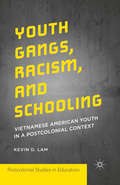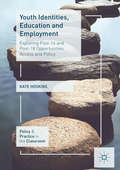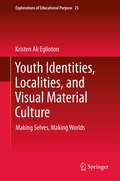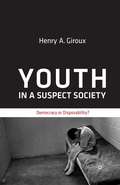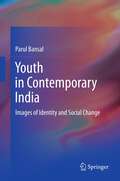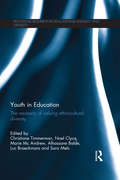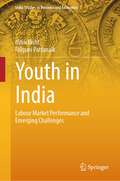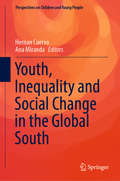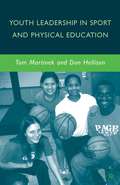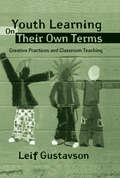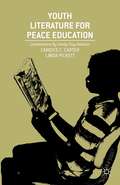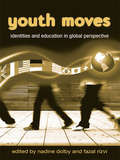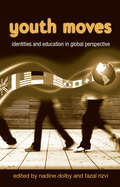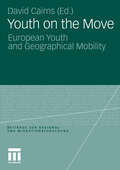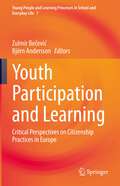- Table View
- List View
Youth Culture and Sport: Identity, Power, and Politics (Critical Youth Studies)
by Michael D. Giardina Michele K. DonnellyYouth Culture and Sport critically interrogates and challenges contemporary articulations of race, class, gender, and sexual relations circulating throughout popular iterations of youth sporting culture in late-capitalism. Written against the backdrop of important changes in social, cultural, political, and economic dynamics taking place in corporate culture’s war on kids, this exciting new volume marks the first anthology to critically examine the intersection of youth culture and sport in an age of global uncertainty. Bringing together leading scholars from cultural studies, gender studies, sociology, sport studies, and related fields, chapters range in scope from 'action' sport subcultures and community redevelopment programs to the cultural politics of white masculinity and Nike advertising. It is a must read for anyone interested in gaining a better understanding of the role sport plays in the construction of experiences, identities, practices, and social differences of contemporary youth culture.
Youth Cultures in a Globalized World: Developments, Analyses and Perspectives
by Hannes Krall Gerald KnappThis book examines the relation between the phenomenon of globalization, changes in the lifeworld of young people and the development of specific youth cultures. It explores the social, political, economic and cultural impact of globalization on young people. Growing diversity in their lifeworlds, technological development, migration and the ubiquity of digital communication and representation of the world open up new forms of self-representation, networking and political expression, which are described and discussed in the book. Other topics are the impact of globalization on work and economy, global environmental issues such as climate change, political movements which put “nationalism first”, change of youth`s values and the significance of body, gender and beauty. The book highlights the challenges of young people in modern life, as well as the way in which they express themselves and engage in society – in culture, politics, work and social life.
Youth, Education and Employment: International Perspectives (Routledge Revivals)
by Keith WatsonFirst published in 1983, Youth, Education and Employment tries to highlight the scale of the problem of youth unemployment in industrial societies by examining it from a variety of angles, and by drawing upon developments in other countries including those of the developing world. Examples are taken from France, Germany, Denmark and Sweden as well as from the United Kingdom, and also from Cuba and small island communities. This important volume shows the underlying causes of youth unemployment and offers positive solutions in particular stressing the need for a reappraisal of many educational practices. This book is a must read for educationists, policy makers and students of public policy.
Youth, Education and Employment: International Perspectives (Routledge Revivals)
by Keith WatsonFirst published in 1983, Youth, Education and Employment tries to highlight the scale of the problem of youth unemployment in industrial societies by examining it from a variety of angles, and by drawing upon developments in other countries including those of the developing world. Examples are taken from France, Germany, Denmark and Sweden as well as from the United Kingdom, and also from Cuba and small island communities. This important volume shows the underlying causes of youth unemployment and offers positive solutions in particular stressing the need for a reappraisal of many educational practices. This book is a must read for educationists, policy makers and students of public policy.
Youth, Education and Risk: Facing the Future
by Peter Dwyer Johanna WynYouth, Education and Risk: Facing the Future provides a provocative and valuable insight into how the dramatic social and economic changes of the last twenty years have affected the lives of Western youth. Covering young people's attitudes towards relationships and health, the authors provide a comprehensive perspective on young people in Western society in the 1990s.The book reviews ten years of research, policy and practice as related to the 15-25 age group and compares data from the UK, Australia, the USA and Canada. It also argues for the need to develop new research and policy frameworks that are more in tune with the changed conditions of life for Western youth. The book sets out the conceptual basis for a new approach to youth and the practical implications for research, education and youth policy in the new millenium.
Youth, Education and Risk: Facing the Future
by Peter Dwyer Johanna WynYouth, Education and Risk: Facing the Future provides a provocative and valuable insight into how the dramatic social and economic changes of the last twenty years have affected the lives of Western youth. Covering young people's attitudes towards relationships and health, the authors provide a comprehensive perspective on young people in Western society in the 1990s.The book reviews ten years of research, policy and practice as related to the 15-25 age group and compares data from the UK, Australia, the USA and Canada. It also argues for the need to develop new research and policy frameworks that are more in tune with the changed conditions of life for Western youth. The book sets out the conceptual basis for a new approach to youth and the practical implications for research, education and youth policy in the new millenium.
Youth Fantasies: The Perverse Landscape of the Media
by Jan JagodzinskiYouth Fantasies is a collection of studies conducted in cross-cultural collaboration over the past ten years that theorizes 'youth fantasy'; as manifested through the media of TV, film, and computer games. Unlike other media studies and education books, the authors employ both Lacanian and Kleinian psychoanalytic concepts to attempt to make sense of teen culture and the influence of mass media. The collection includes case studies of X-Files fans, the influence of computer games and the 'Lara Croft' phenomenon, and the reception of Western television by Tanzanian youth. The authors see this book as a much needed reconciliation between cultural studies and Lacanian psychoanalysis, and attempt to highlight why Lacan is important to note when exploring youth fantasy and interest in the media, especially in shows like X-Files .
The Youth Gang Problem: A Community Approach
by Irving A. SpergelEvery day there are new stories of gang-related crime: from the proliferation of illegal weapons in the streets and children dealing drugs in their schools, to innocent bystanders caught in the crossfire of never-ending gang wars. Once considered an urban phenomenon, gang violence is permeating American life, spreading to the suburbs and bringing the problem closer to home for much of America. The government, schools, social agencies, and the justice system are conspicuous by their sporadic interest in the subject and have failed to develop effective policies and programs. Existing social support mechanisms and strategies for suppressing violence have often been unsuccessful. And, state and federal policy is largely nonexistent. In The Youth Gang Problem: A Community Approach, Irving Spergel provides a systematic analysis of youth gangs in the United States. Based on research, historical and comparative analysis, and agency documents and the author's extensive first-hand experience, the work explores the gang problem from the perspective of community disorganization, especially population movement, and the plight of the underclass. It examines the factors of gang member personality, gang dynamics, criminal organization, and the influence of family, school, prisons, and politics, as well as the response of criminal justice agencies and community groups. Spergel describes techniques used by social agencies, schools, employment programs, criminal justice agencies, and grass-roots organizations for dealing with gangs, and recommends strategies that emphasize the use of local resources, planning, and collaborative procedures. There is no single strategy and no easy solution to the youth gang problem in the United States. There are, however, substantial steps we can take, and they must be honestly and systematically tested. Offering a practical and alternative approach to a serious social problem, The Youth Gang Problem: A Community Approach is a major and long-awaited contribution to this dilemma. It is required reading for criminal justice personnel, school staff, social workers, policy makers, students and scholars of urban and organizational sociology, and the general reader concerned with the youth gang problem and how to control, intervene, and prevent it.
Youth Gangs, Racism, and Schooling: Vietnamese American Youth in a Postcolonial Context (Postcolonial Studies in Education)
by Kevin D. LamWinner of the American Educational Studies Association 2016 Critics' Choice Book AwardYouth Gangs, Racism, and Schooling examines the formation of Vietnamese American youth gangs in Southern California. Lam addresses the particularities of racism, violence, and schooling in an era of anti-youth legislation and frames gang members as post-colonial subjects, offering an alternative analysis toward humanization and decolonization.
Youth Identities, Education and Employment: Exploring Post-16 and Post-18 Opportunities, Access and Policy (Policy and Practice in the Classroom)
by Kate HoskinsThis book investigates how policy, family background, social class, gender and ethnicity influence young people’s post-16 and post-18 employment and education access. It draws on existing literature, alongside new data gathered from a case study in a UK state secondary school, to examine how policy changes to the financial arrangements for further and higher education and the changing youth employment landscape have had an impact on young people’s choices and pathways. Hoskins explores a number of topics, including the role of identity in young people’s decision-making; the impact of changes to young people’s financial arrangements, such as cuts to the Education Maintenance Allowance and increased university fees; and the influence of support from parents and teachers. The book will be of interest to students and researchers of Education and Sociology.
Youth Identities, Localities, and Visual Material Culture: Making Selves, Making Worlds (Explorations of Educational Purpose #25)
by Kristen Ali EglintonThis invaluable addition to Springer’s Explorations of Educational Purpose series is a revelatory ethnographic account of the visual material culture of contemporary youths in North America. The author’s detailed study follows apparently dissimilar groups (black and Latino/a in a New York City after-school club, and white and Indigenous in a small Canadian community) as they inflect their nascent identities with a sophisticated sense of visual material culture in today’s globalized world. It provides detailed proof of how much ethnography can add to what we know about young people’s development, in addition to its potential as a model to explore new and significant avenues in pedagogy. Supported by a wealth of ethnographic evidence, the analysis tracks its subjects’ responses to strikingly diverse material ranging from autobiographical accounts by rap artists to the built environment. It shows how young people from the world’s cultural epicenter, just like their counterparts in the sub-Arctic, construct racial, geographic and gender identities in ways that are subtly responsive to what they see around them, blending localized characteristics with more widely shared visual references that are now universally accessible through the Web. The work makes a persuasive case that youthful engagement with visual material culture is a relational and productive activity that is simultaneously local and global, at once constrained and enhanced by geography, and possesses a potent and life-affirming authenticity. Densely interwoven with young people’s perspectives, the author’s account sets out an innovative and interdisciplinary conceptual framework affording fresh insights into how today’s youth assimilate what they perceive to be significant.Supported by a wealth of ethnographic evidence, the analysis tracks its subjects’ responses to strikingly diverse material ranging from autobiographical accounts by rap artists to the built environment. It shows how young people from the world’s cultural epicenter, just like their counterparts in the sub-Arctic, construct racial, geographic and gender identities in ways that are subtly responsive to what they see around them, blending localized characteristics with more widely shared visual references that are now universally accessible through the Web. The work makes a persuasive case that youthful engagement with visual material culture is a relational and productive activity that is simultaneously local and global, at once constrained and enhanced by geography, and possesses a potent and life-affirming authenticity. Densely interwoven with young people’s perspectives, the author’s account sets out an innovative and interdisciplinary conceptual framework affording fresh insights into how today’s youth assimilate what they perceive to be significant.Supported by a wealth of ethnographic evidence, the analysis tracks its subjects’ responses to strikingly diverse material ranging from autobiographical accounts by rap artists to the built environment. It shows how young people from the world’s cultural epicenter, just like their counterparts in the sub-Arctic, construct racial, geographic and gender identities in ways that are subtly responsive to what they see around them, blending localized characteristics with more widely shared visual references that are now universally accessible through the Web. The work makes a persuasive case that youthful engagement with visual material culture is a relational and productive activity that is simultaneously local and global, at once constrained and enhanced by geography, and possesses a potent and life-affirming authenticity. Densely interwoven with young people’s perspectives, the author’s account sets out an innovative and interdisciplinary conceptual framework affording fresh insights into how today’s youth assimilate what they perceive to be significant.
Youth in a Suspect Society: Democracy or Disposability?
by H. GirouxThrough the lens of education, this book attempts to situate young people within a number of theoretical and political considerations that offer up a new 'analytic of youth', one that posits not only the emergence of a new way to talk about youth but also a new language for understanding the politics that increasing frame their lives.
Youth in Contemporary India: Images of Identity and Social Change
by Parul BansalThis book endeavors to be a study of identity in Indian urban youth. It is concerned with understanding the psychological themes of conformity, rebellion, individuation, relatedness, initiative and ideological values which pervade youths’ search for identity within the Indian cultural milieu, specifically the Indian family. In its essence, the book attempts to explore how in contemporary India the emerging sense of individuality in youth is seeking its own balance of relationality with parental figures and cohesion with social order. The research questions are addressed to two groups of young men and women in the age group of 20-29 years-Youth in Corporate sector and Youth in Non Profit sector. Methodologically, the study is a psychoanalytically informed, process oriented, context sensitive work that proceeds via narrations, conversations and in-depth life stories of young men and women. Overall, the text reflects on the nature of inter-generational continuity and shifts in India.
Youth in Education: The necessity of valuing ethnocultural diversity (Routledge Research in Educational Equality and Diversity)
by Christiane Timmerman, Noel Clycq, Marie Mc Andrew, Alhassane Balde, Luc Braeckmans and Sara MelsYouth in Education explores the multiple, interrelated social contexts that young people inhabit and navigate, and how educational institutions cope with increasing ethnic, cultural and ideological diversity. Schools, families and communities represent important settings in which young people must make successful transitions to adulthood, and the classroom often becomes a battleground in which these contexts and values interact. With contributions from the UK, Belgium, Germany and Canada, the chapters in this book explore rich examples from Europe and North America to suggest strategies that can help to counter negative perceptions, processes of stigmatization and disengagement, instead prioritising peer support and cooperative learning to give pupils a renewed sense of worth. This book takes the growing ethno-cultural diversity in education systems to heart and studies the various related educational processes from a multidisciplinary and multi-method approach. It aims to offer more insight into underlying mechanisms that are often implicit, but can be important factors that positively or negatively influence educational trajectories and outcomes. It is essential reading for researchers, academics and postgraduate students in the fields of education, sociology, higher education, policy and politics, and social and cultural geography.
Youth in Education: The necessity of valuing ethnocultural diversity (Routledge Research in Educational Equality and Diversity)
by Christiane Timmerman Noel Clycq Marie Mc Andrew Alhassane Balde Luc Braeckmans Sara MelsYouth in Education explores the multiple, interrelated social contexts that young people inhabit and navigate, and how educational institutions cope with increasing ethnic, cultural and ideological diversity. Schools, families and communities represent important settings in which young people must make successful transitions to adulthood, and the classroom often becomes a battleground in which these contexts and values interact. With contributions from the UK, Belgium, Germany and Canada, the chapters in this book explore rich examples from Europe and North America to suggest strategies that can help to counter negative perceptions, processes of stigmatization and disengagement, instead prioritising peer support and cooperative learning to give pupils a renewed sense of worth. This book takes the growing ethno-cultural diversity in education systems to heart and studies the various related educational processes from a multidisciplinary and multi-method approach. It aims to offer more insight into underlying mechanisms that are often implicit, but can be important factors that positively or negatively influence educational trajectories and outcomes. It is essential reading for researchers, academics and postgraduate students in the fields of education, sociology, higher education, policy and politics, and social and cultural geography.
Youth in India: Labour Market Performance and Emerging Challenges (India Studies in Business and Economics)
by Nitin Bisht Falguni PattanaikThis book provides an overview of youth labour force and workforce participation in India and explores the dynamics of changing youth labour market in India. Despite notifying a demographic dividend phase, a significant share of youth witnessed higher exclusion (unemployment and not in employment, education or training) from the Indian labour market. Therefore, this book investigates the role of education in labour market and examines open unemployment. It conceptualizes the not-in-employment-education-or-training (NEET) status of youth in Indian context and explores the heterogeneity of NEET youth by analysing the push and pull role of demographic and socio-economic variables. Furthermore, this book examines the nexus of youth labour market status and economic growth in India to provide plausible recommendations for youth's higher, inclusive and sustained participation in the labour market and the country's development pathway. The book creates room for necessary policy interventions considering the changing dynamics of youth labour market and contemplating the challenges of skill, technology and Industry 4.0., which entails a higher emphasis on ‘re-shape’, ‘re-focus’ and ‘re-share’ for enhanced and sustained inclusion of youth in labour market. It is a necessary resource for students, researchers, policymakers, and industry partners interested in exploring and understanding the political economy of youth labour market in India.
Youth, Inequality and Social Change in the Global South (Perspectives on Children and Young People #6)
by Hernan Cuervo Ana MirandaThis book gathers international and interdisciplinary work on youth studies from the Global South, exploring issues such as continuity and change in youth transitions from education to work; contemporary debates on the impact of mobility, marginalization and violence on young lives; how digital technologies shape youth experiences; and how different institutions, cultures and structures generate a diversity of experiences of what it means to be young. The book is divided into four broad thematic sections: (a) Education, work and social structure; (b) Identity and belonging; (c) Place, mobilities and marginalization; and (d) Power, social conflict and new forms of political participation of youth.
Youth Leadership in Sport and Physical Education
by D. Hellison T. MartinekThis book responds to the needs of urban youth by describing youth development principles in physical activity programs. These programs are built on urban kids' assets and promise rather than their deficits. Included are ways of transferring skills from specific programs to everyday settings.
Youth Learning On Their Own Terms: Creative Practices and Classroom Teaching (Critical Youth Studies)
by Leif GustavsonYouth Learning On Their Own Terms convincingly shows how developing a respect and understanding of the youth-initiated creative practices that occur outside schools can offer educators the opportunity to directly influence their teaching in schools by making classroom spaces personally meaningful and rigorous for both students and teachers.
Youth Learning On Their Own Terms: Creative Practices and Classroom Teaching (Critical Youth Studies)
by Leif GustavsonYouth Learning On Their Own Terms convincingly shows how developing a respect and understanding of the youth-initiated creative practices that occur outside schools can offer educators the opportunity to directly influence their teaching in schools by making classroom spaces personally meaningful and rigorous for both students and teachers.
Youth Literature for Peace Education
by C. Carter L. PickettCarter and Pickett explore how educators and families can teach peace education through youth literature and literacy development. Showing how to assess, choose, and make use of literature that can be used to teach both literacy and peace education, they walk through individual methods: recognizing and teaching different portrayals of conflict in youth literature, analyzing characterization, and examining the role of illustrations. Educators who want to incorporate peace education within a broader, literacy-focused curriculum, and peace educators looking for age-appropriate materials and methodologies will find Youth Literature for Peace Education a rich and interdisciplinary resource.
Youth Moves: Identities and Education in Global Perspective (Critical Youth Studies)
by Nadine Dolby Fazal RizviThis fascinating collection of original essays seeks to address the possibilities and dangers of young people's transnational, commodified identities; how society and educational institutions might respond to these new identities; and the consequences for democratic practices and the public sphere. Drawing together contributions from the work of both well known and emerging scholars, this collection highlights the practices of youth’s identities in the context of broadly defined educative sites, including schools, media and popular culture, community organisations, cyberspace, music, and urban landscapes.
Youth Moves: Identities and Education in Global Perspective (Critical Youth Studies)
by Nadine Dolby Fazal RizviThis fascinating collection of original essays seeks to address the possibilities and dangers of young people's transnational, commodified identities; how society and educational institutions might respond to these new identities; and the consequences for democratic practices and the public sphere. Drawing together contributions from the work of both well known and emerging scholars, this collection highlights the practices of youth’s identities in the context of broadly defined educative sites, including schools, media and popular culture, community organisations, cyberspace, music, and urban landscapes.
Youth on the Move: European Youth and Geographical Mobility (Beiträge zur Regional- und Migrationsforschung)
by David CairnsYouth Participation and Learning: Critical Perspectives on Citizenship Practices in Europe (Young People and Learning Processes in School and Everyday Life #7)
by Zulmir Bečević Björn AnderssonThis book contributes to the studies on learning processes occurring outside “traditional” socialization settings such as family and school, by analysing civic and political participation and learning experiences. In this perspective, the book delves into the connections between the concepts of learning and participation and, in various ways and from different perspectives, critically interrogates learning and participation as interrelated phenomena, with the aim of revealing complexities implicated in pathways to adulthood. Being interdisciplinary in its nature (contributors come from disciplinary backgrounds such as educational sciences, child and youth studies, social work, sociology and political science), the volume provides an up-to date analysis of contemporary issues connected to youth participation and learning. The work taps into central areas of everyday life of young people and youth meaning-making and generates and presents qualitative knowledge about what it means to be young in Europe today.
